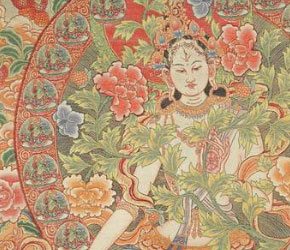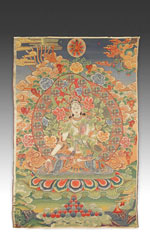Five Taras or Goddess Tara
 |
|
This exceptional altar cover depicts the
Many myths surround the creation of the goddess
There are five Taras, each corresponding to a different color. They represent the following:
 |
|
White Tara: symbolizes transcendent knowledge and perfect purity.
Green Tara: the original Tara who gave rise to all others. When shown with the other Taras she is considered to be the goddess of good fortune.
Yellow Tara: she is said to have been born from a frown on the face of Avalokitesvara and represents his wrathful form; thus she can be viewed as the guardian of loving and compassionate beings.
Blue Tara: the fierce assistant of the Green Tara, she is typically represented in paintings and can be viewed as protecting the Taras as well as all good beings.
Red Tara: represents the power of love of the original Tara.
Download this Article: Five Taras.pdf